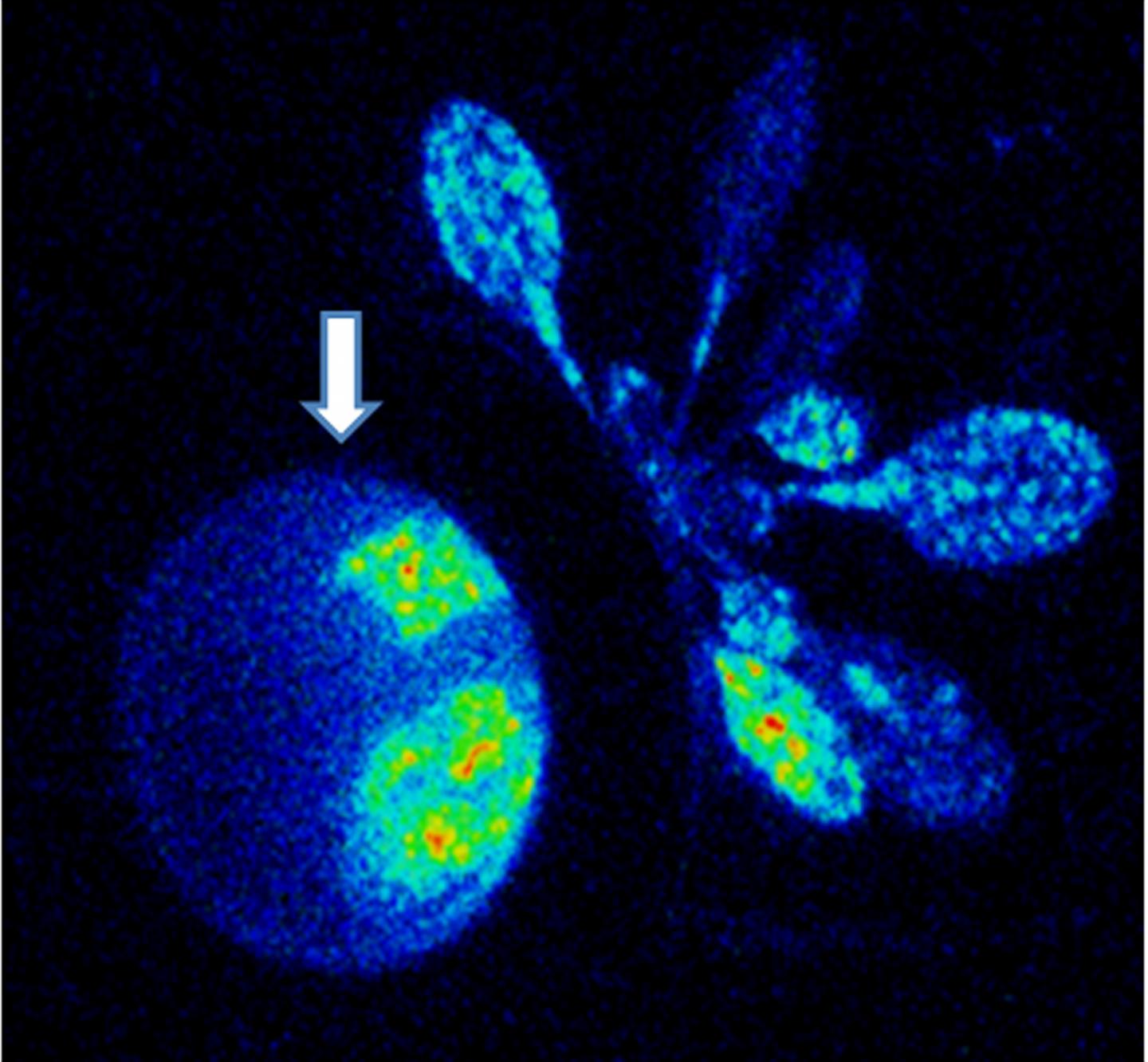When a plant is attacked by herbivores, this triggers a number of physiological responses in the plant and calcium ions are important messengers for the processing of wound signals in plant cells. They regulate signal transduction and indirectly control plant defense mechanisms.
Now, scientists have succeeded in visualizing the immediate wound or herbivory responses in plants. They used Arabidopsis thaliana (thale cress) plants that produce a special protein which breaks down after the binding of calcium ions and emits free energy in the form of light. The amount of light corresponds to the calcium concentrations in the cells of the respective leaf areas.
By using a highly sensitive camera system the researchers could track the calcium flow in the plants. Visualization revealed that calcium signals occur systemically and wander from attacked to neighboring leaves within a short period of time, and ultimately put the whole plant into a state of defense readiness.

The amounts of light accumulated over a period of 30 minutes, highlighting the changing calcium concentrations. These are represented by a color code (blue=low, red=high). Credit: Victoria Kiep / Martin Luther University, Halle-Wittenberg; Jyothilakshmi Vadassery / Max Planck Institute for Chemical Ecology
Calcium is a universal intracellular messenger. In plants, many physiological processes are mediated by calcium ions, especially responses to abiotic and biotic stresses, such as feeding caterpillars. These trigger the activation of a number of defense mechanisms. If a leaf is attacked by an insect, the wound signal which emanates from the affected leaf is transmitted to other, unattacked leaves.
In order to visualize this signal, the scientists performed experiments with transgenic Arabidopsis plants which were genetically modified to express a protein in the cytosol, the liquid inside the cells, which breaks down and releases light energy after it has bound calcium ions.
The emitted light energy correlates with the respective concentrations of calcium ions. In this way, intracellular changes of calcium levels can be determined directly. Moreover, these processes can be made visible in the plants by applying a highly sensitive camera system which uses charge-coupled devices (CCD).
"It is very impressive to see how every bite of a caterpillar makes certain leaf areas shine. The immediate reaction of the plants is clearly visible," says Victoria Kiep, who carried out most of the experimental work together with Jyothilakshmi Vadassery.
It was very important for the researchers to show that the calcium signal is a systemic process, rather than a local one, as it wanders from the attacked leaf to neighboring leaves within a few minutes to trigger the subsequent defense responses. "We succeeded in visualizing the dynamic signal processing of intracellular calcium as a secondary messenger which is elicited by insect feeding and transmitted systemically to unattacked areas of the plant," Axel Mithöfer, the leader of the project group "Physiology of Plant Defense" in the Department of Bioorganic Chemistry, summarizes the results of the study.
How calcium signals are elicited in different and separate areas of plants is not yet fully understood. However, the scientists speculate that electric signals which are transmitted via the vascular system of plants, so-called vascular bundles, play an important role. There are no important differences between calcium signals which are elicited by mechanical wounding and those which are triggered by feeding caterpillars.
Surprisingly, the application of larval oral secretions inhibited the transduction of calcium signals to neighboring leaves in the experiment. Of general importance for systemic calcium signaling is the wounding of the vascular system of the leaf, which is also responsible for the internal transport of water and nutrients in the plant.
Further experiments are planned in order to find out which kind of wounding triggers the systemic calcium signal, for example, whether a similar wound response is elicited by aphids and spider mites, as these insects puncture the plant tissue to suck the plant sap and damage the tissue only slightly.
The scientists would like to investigate how signal transduction is achieved in grasses whose vascular bundles are structured differently in comparison to Arabidopsis which belongs to the Brassicaceae family. They are also interested in determining the operating distance of calcium signals in general and would like to answer the question whether the signals can be transmitted to the plant roots.
This study demonstrates that calcium signals, which are necessary for eliciting plant defense responses, and their spatial and temporal expansion can be visualized. Moreover, the scientists showed that calcium signaling can be studied directly in intact plants in different physiological and ecological contexts, which helps to better understand its role as a secondary messenger in plants. [AO/AM]
Citation: Kiep, V., Vadassery, J., Lattke, J., Maaß, J.-P., Boland, W., Peiter, E., Mithöfer, A. (2015). Systemic cytosolic Ca2+ elevation is activated upon wounding and herbivory in Arabidopsis. New Phytologist. doi: 10.1111/nph.13493






Comments